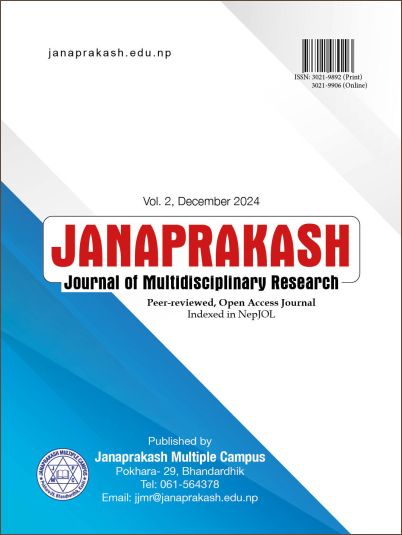Assessing the Impact of Credit Risk on the Financial Performance of Commercial Banks in Nepal
DOI:
https://doi.org/10.3126/jjmr.v2i1.75166Keywords:
Commercial banks, credit risk, financial performance, Nepal, profitabilityAbstract
This study explores the impact of credit risk on the financial performance of Nepalese commercial banks, focusing on critical performance indicators such as Return on Assets (ROA), Return on Equity (ROE), and liquidity ratios. The primary objective of this study is to evaluate the relationship between credit risk factors such as Non-Performing Loan Ratio (NPLR), Loan Loss Provision Ratio (LLPR), Capital Adequacy Ratio (CAR), and Credit Risk Ratio (CRR), and key financial metrics, and their influence on profitability and stability. Adopting a positivist research philosophy, the study employs a quantitative methodology using secondary data from the annual reports of commercial banks. The population consists of all commercial banks operating in Nepal, while a sample of seven banks was selected through the lottery method, a random sampling technique. Correlation and regression analyses were conducted to examine the relationships between the variables. The results disclose significant negative correlations between NPLR and both LAR and CAR, indicating adverse impacts of rising non-performing loans on asset leveraging and capital adequacy. Conversely, NPLR positively correlates with ROE, highlighting complex dynamics where banks with higher credit risks may achieve increased equity returns under certain conditions. Regression analysis indicates that LLPR and CRR negatively influence both ROA and ROE, whereas CAR positively impacts profitability. The findings highlight the critical importance of effective Credit Risk Management (CRM) in enhancing financial performance. Banks must balance lending activities with risk management to maintain profitability and stability. The study concludes that robust CRM strategies are essential for mitigating credit risks and sustaining growth in Nepal’s banking sector. These findings hold implications for policymakers, regulators, and practitioners aiming to strengthen the resilience of financial institutions in developing economies.
Downloads
Downloads
Published
How to Cite
Issue
Section
License
Copyright (c) 2024 The Author(s)

This work is licensed under a Creative Commons Attribution-NonCommercial 4.0 International License.
This license enables reusers to distribute, remix, adapt, and build upon the material in any medium or format, so long as attribution is given to the creator. The license allows for commercial use.




